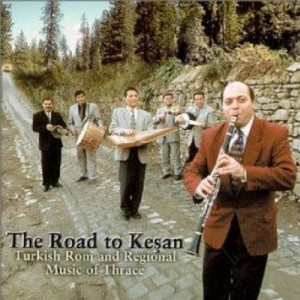 Brendan Foreman penned this review.It continues to be a great time for the traditional music lover, especially now that Rounder Records has begun distributing the music of Traditional Crossroads, a record company in New York that specializes in the music of the Middle East, i.e. at the crossroads of Europe, Asia, and Africa.
Brendan Foreman penned this review.It continues to be a great time for the traditional music lover, especially now that Rounder Records has begun distributing the music of Traditional Crossroads, a record company in New York that specializes in the music of the Middle East, i.e. at the crossroads of Europe, Asia, and Africa.
Indeed the music of this particular CD sounds like it was recorded at a very, very busy crossroads. This is the music of the Turkish Rom and of Thrace (the northern coastal region of the Mediterranean between Greece and Turkey). This area has been the scene of migration after migration since the days of Pericles. Everyone from Eastern Europe and the Near East seems to have passed through Thrace at some time or another: Greeks, Turks, Jews, numerous Slavs, all leaving a little bit of themselves in the area.
For their music, the Rom of the region — already a nomadic people — seemed to have picked up a little from everyone they’ve met. Swirling together in a beguiling mixture of sounds, you can hear snatches of klezmer, Greek traditions, even some good old Eastern European dissonance added to the highly syncopated beats that are so popular in the Middle East. At times, you can even hear some of the medieval Spanish music that the Sephardic Jews brought with them after the Diaspora of 1492.
This CD showcases the superb playing of clarinettist Selim Sesler and his band, consisting of Nusret Sute on the violin; Bulent Sesler on the kanun (a Turkish version of the zither); Turan Gumus on the cumbus (more or less a Turkish banjo); Selahattin Kocan on the darbuka and daire (both percussion instruments); and Ramadan Borozan on the duval (another type of percussion). This ensemble is one of many professional musical groups among the Rom, a people who have managed to keep their traditions quite vigorous.
The music of The Road to Kesan focuses on the music of celebrations, mostly wedding melodies in fact. This is exuberant, heady music that was made for dancing — and very enjoyable to listen to. Among the 9/8 and 7/4 rhythms, Sesler gives his group plenty of time for solos and interesting arrangements. His clarinet has an almost sorrowful tone to it, that is nicely contrasted with the otherworldly tones of the kanun played by his son, Bulent. When not soloing, Gumus and Sute play back-up. The percussionists Kocan and Borozan are ever-present, pounding forthrightly on their percussion instruments and keeping the music flowing stridently.
The liner notes of this CD are particularly superb. Not only do they give a nice geographical description of the region near Kesan and little bit of its history, they also describe its musical culture. One can also find details about the musicians, their instruments, and the songs that they play on the CD. I should note that Sonia Sesler, a researcher in the Macedonian and Turkish music, is the one who wrote the liner notes. She’s done an excellent job.
This CD is really a “must have” item for anyone who has interest in East European and Near Eastern music. It’s rare to find a package that is as well done as this one.
(Traditional Crossroads, 2000)
